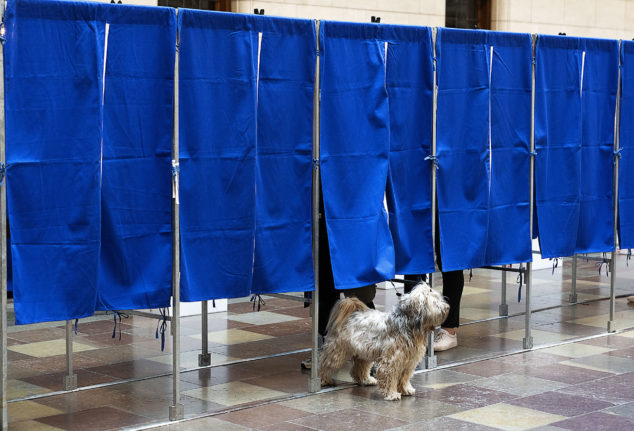Danish politics is hard to follow even for those with a lifetime’s experience of the political system and fluency in the language. For foreigners trying to follow events, it can be extremely confusing.
But once you’re armed with a bit of background knowledge and some Danish political vocabulary, the country’s politics does get easier to understand (at least, most of the time).
With Denmark preparing for what could be a knife-edge election on Tuesday, November 1st, here’s our guide to the key phrases, terminology and names you’ll need.
READ ALSO: Denmark to hold election on November 1st
The basics
The word for ‘election’ is valg, which also means ‘choice’, just to make things extra confusing for Danish learners.
Denmark has three types of election: folketingsvalget (the election for the national parliament), regionalvalget (the regional election) and kommunalvalget (the municipal election).
These do not take place at the same time. The latter two, both local elections, were last held in 2021.
That leaves the country to fully concentrate on November 1st on voting for the next regering (government) to take its place in the folketing or parlament (parliament) at Christiansborg, the seat of the parliament in Copenhagen.
Danish citizens over the age of 18 have stemmeretten (the right to vote). But although the national election tends to get more attention, non-citizens should know that they may be able to stemme (vote) in the regional and local elections.
If you’re stemmeberettiget (eligible to vote), either as a Danish national or as a foreigner in local elections, you will receive a valgkort (voting card) in the post.
Prior to elections, you are likely to see increasing reference to meningsmålinger (opinion polls) showing which parties are ahead and which are lagging as voting day nears.
The campaigning
The valgkampagne (election campaign or election season) is already underway with the parties falling over themselves trying to present the most attractive valgløfter (campaign promises) or, if you want to be more cynical, valgflæsk (overly generous promises; literally ‘election pork’).
Broadcasters DR and TV2 have already shown the first partilederdebat (party leader debate), with several more presumably to come. During these debates, there’s a good chance one party leader will accuse another of saying things that are floskler (empty phrases or platitudes).
The voting
Voters are permitted to brevstemme (literally ‘vote by letter’ but meaning to vote in advance). On November 1st, valgdagen (the day of the election), valglokaler and valgsteder (polling stations) will presumably have long queues.
At polling stations, voters take the stemmeseddel (ballot paper) and sætter kryds (place a cross) next to their preferred parti (party), before placing it in the stemmeurn (ballot box).
In most valgkredser (constituencies) there will be the option to stemme personligt, which is when you tick the name of a specific candidate who you think should represent the party as folketingsmedlem (member of parliament). Voters can also just vote for the liste, meaning they give a general vote to a party.
Alternatively, people may choose to stemme blankt, which is when you do turn up at the polling station on the day, but instead of voting you put a blank slip of paper in the ballot box as a form of protest.
Denmark generally enjoys high valgdeltagelse (voter turnout). In the 2019 election more than 84 percent of more than 4.2 million eligible voters cast their vote.
The contenders
There are as many as 13 different Danish parties in parliament currently.
Their names are (deep breath): Socialdemokratiet (Social Democrats), Venstre (Liberal), Socialistisk Folkeparti (Socialist People’s Party, usually shorted to SF), Radikale Venstre (Social Liberals), Enhedslisten (Red Green Alliance), Det Konservative Folkeparti (Conservatives), Danmarksdemokraterne (Denmark Democrats), Dansk Folkeparti (Danish People’s Party, sometimes shortened to DF), Nye Borgerlige (no official English name but translates to New Right), Liberal Alliance (Liberal Alliance), Frie Grønne (Independent Greens), Alternativet (The Alternative) and Moderaterne (Moderates).
A number of members of parliament are meanwhile uden for folketingsgrupperne or løsgængere (independent).
You may have noticed that the Liberal party’s Danish name is Venstre, which is actually the word for ‘left’. Confusingly, Venstre are a højrefløjsparti (right wing party), even though their name suggests they are venstreorienteret (on the left).
READ ALSO: OPINION: Why do the names of Danish political parties have to be so confusing?
The current government is led by the Social Democrats, who are a venstrefløjsparti (left wing party) and part of the rød bloc (‘red bloc’) of allied parties on the left wing.
The traditional opponents are højrefløjen (the right wing), also referred to as blå bloc (the ‘blue bloc’) and sometimes de borgerlige (the bourgeois – which doesn’t automatically have the same strong connotations in Danish as in English).
This has the potential to change after the election. Prime Minister Mette Frederiksen has said she wants to form a bred regering (‘broad government’), meaning a centre coalition or a cross-aisle government. That would break with Denmark’s established ‘bloc politics’ system which sees the left- and right-wing parties in opposing factions.
READ ALSO: ‘Bloc politics’: A guide to understanding parliamentary elections in Denmark
The future
According to meningsmålinger (opinion polls), the two blocs could be very close following the vote on November 1st. That could mean lengthy post-election forhandlinger (negotiations), especially with Frederiksen adding to the intrigue by talking up a government which spans hen over midten (‘across the centre’).
The current government is a mindretalsregering (minority government), but this might not be the case if several parties come together to form a koalitionsregering (coalition government).
The siddende statsminister (incumbent prime minister) continues after the election if they have a majority of Denmark’s 179 MPs behind them – meaning their own party along with allied parties has an overall majority.
If the incumbent loses the election, a new prime minister must be found. This is done through a process known as a dronningerunde (literally a ‘Queen’s round’). Here, the leader of each party has an audience with the Queen. After this, the Queen nominates a person to lead the new government or lead negotiations to form it.
The leader of the losing bloc can also concede the election.
Once a new prime minister and government is in place, they are formally nominated by the Queen at Amalienborg Palace in Copenhagen before emerging and facing the public on the palace square.
Can you think of any other Danish political words? Let us know and we’ll add them to the list.



 Please whitelist us to continue reading.
Please whitelist us to continue reading.
Member comments